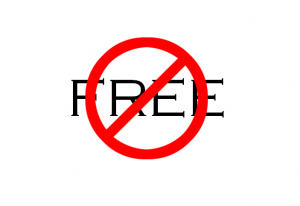The adage “there’s no such thing as a free lunch” certainly holds in business. In fact, another adage suggests quite the opposite- “you’ve got to spend money to make money.” The rise of social media as a communication channel held promise to turn these notions upside down. Yes, you could enjoy a free lunch, or should I say free advertising, by joining Facebook, Twitter, YouTube, and other relevant social networking sites. I confess that I bought into it; in the earlier days of social media marketing I touted “free” as a strength of social media to my students. And, perhaps I was technically correct. However, today’s landscape in which brand building occurs on social networking sites reflects that free lunch is no longer being served, if it was ever being served at all.
What Has Changed
So, what happened to the free advertising lunch on social networking sites? The main development has been the evolution of social nets’ advertising models. Facebook is a prime example. Remember those annyoing display ads that would appear beside your feed? Recipients were asked to indicate if the ads were relevant or even if they were offensive. Today, ads you see in your news feed are native to the environment, serving you contextually relevant messages based on your characteristics and interests. This push toward relevant messaging comes at a price for message senders (advertisers). If you want your message to cut through the clutter on Facebook or other social nets, your best option may be to pay for prominent placement.
Another reason has emerged for giving up on the notion of social media being the equivalent of free advertising. On Facebook, non-paid messages from businesses are more likely to not have a reach equivalent to a brand’s total audience. Facebook’s latest tweak of its algorithm favors messages that offer compelling content, quality over quantity, if you will. And of course, Facebook will favor placement of sponsored posts (i.e., ads). Blogger Derek Muller shared observations he made in how impressions of posts to his Veritasium Facebook page dropped dramatically following Facebook’s algorithm change late last year. Some posts reached as few as 8% of Vertiasium’s Facebook audience. Likes are no longer enough to get into news feeds; engagement with posts are now more important in achieving relevant placement in an audience’s news feeds.
Exposure versus Impact
The decline in reach some brands have experienced since the latest changes to the Facebook algorithm should serve as notice that “free advertising” via social media has become a distant memory as the business models of social nets have evolved. There are two considerations on this issue:
- Exposure is free – The claimed free advertising advantage of social media holds in that establishing a presence can be done without paying for space or time as required in traditional media. Embarking on social media marketing can be pulled off with as little as a keyboard and Internet connection. Given that there are very low barriers to entry, businesses should be suing social media to build exposure for their brands.
- Impact is not free – Stories of deeply diminished reach on Facebook brand pages bring out the new reality that if you want to maximize impact on social nets like Facebook and Twitter you should expect to pay to do so. There are compelling reasons to commit to invest in native advertising on social nets- audiences can be narrowly targeted and promoted messages can help you rise above the clutter and receive prominent placement.
Value Comes at a Price
So there is no free lunch when it comes to social media marketing- why should we be surprised or upset? Facebook and Twitter possess something of great value to brands: Access to coveted audiences. It does not make business sense to give away something of commercial value. With that said, it must be priced fairly, and buyers must get good value for their investments. And, if social nets do not deliver value through their advertising platforms, brands will speak by finding other channels to communicate.

